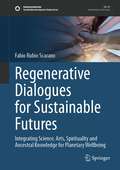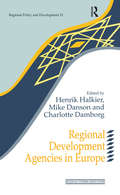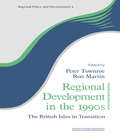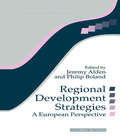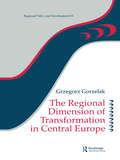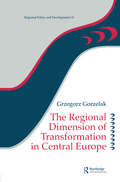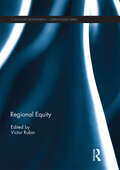- Table View
- List View
Regenerative by Design: Creating living buildings and cities
by David CheshireHow do we design cities and buildings that metabolise, use living materials and are net positive - that give back more to the planet than they take?Our cities and buildings are a drain on the planet, requiring huge amounts of resources and tracts of land to support their needs, and destroying biodiversity in the process. The idea of living, regenerative buildings is gaining ground - buildings that give back more than they take, providing habitats, ecosystems services (e.g. clean water, clean air), locally-grown food, and putting humans back in touch with the natural world.The climate and biodiversity crisis has driven organisations to set ambitious net zero carbon and ESG targets: however, many are struggling to see how to achieve them and often doing the same thing, but expecting a different result.This book sets out the regenerative building agenda and design principles, showing how buildings, towns and cities could start to have a positive impact on our planet, providing ecosystems services and living within the means afforded by the site.
Regenerative by Design: Creating living buildings and cities
by David CheshireHow do we design cities and buildings that metabolise, use living materials and are net positive - that give back more to the planet than they take?Our cities and buildings are a drain on the planet, requiring huge amounts of resources and tracts of land to support their needs, and destroying biodiversity in the process. The idea of living, regenerative buildings is gaining ground - buildings that give back more than they take, providing habitats, ecosystems services (e.g. clean water, clean air), locally-grown food, and putting humans back in touch with the natural world.The climate and biodiversity crisis has driven organisations to set ambitious net zero carbon and ESG targets: however, many are struggling to see how to achieve them and often doing the same thing, but expecting a different result.This book sets out the regenerative building agenda and design principles, showing how buildings, towns and cities could start to have a positive impact on our planet, providing ecosystems services and living within the means afforded by the site.
Regenerative Development and Design: A Framework for Evolving Sustainability
by Regenesis GroupThe evolution of sustainability, with a practical framework for integration Regenerative Development and Design takes sustainability to the next level, and provides a framework for incorporating regenerative design principles into your current process. The Regenesis Group is a coalition of experienced design, land-use, planning, business, and development professionals who represent the forefront of the movement; in this book, they explain what regenerative development is, how and why it works, and how you can incorporate the fundamental principles into your practice. A clear, focused framework shows you how to merge regenerative concepts with your existing work, backed by numerous examples that guide practical application while illustrating regenerative design and development in action. As the most comprehensive and systemic approach to regenerative development, this book is a must-have resource for architects, planners, and designers seeking the next step in sustainability. Regenerative design and development positions humans as co-creative and mutually-evolving participants in an ecosystem—not just a built environment. This book describes how to bring that focus to your design from the earliest stages. Understand the fundamentals of regenerative design and development Learn how regenerative development contributes to sustainability Integrate regenerative development concepts into practice Examine sample designs that embody the regenerative concept To create a design with true sustainability, considerations must extend far beyond siting, materials, and efficiency. Designers must look at the place, it's inhabitants, and the purpose—the whole living ecosystem—and proceed with their work from that more humbling perspective. The finished product should itself be an ecosystem and sustainable economy, which is the root of the regenerative development approach. Sustainability has evolved, and the designer's responsibility has increased in kind. Regenerative Development and Design provides an authoritative resource for those ready to take the next step forward.
Regenerative Development and Design: A Framework for Evolving Sustainability
by Regenesis GroupThe evolution of sustainability, with a practical framework for integration Regenerative Development and Design takes sustainability to the next level, and provides a framework for incorporating regenerative design principles into your current process. The Regenesis Group is a coalition of experienced design, land-use, planning, business, and development professionals who represent the forefront of the movement; in this book, they explain what regenerative development is, how and why it works, and how you can incorporate the fundamental principles into your practice. A clear, focused framework shows you how to merge regenerative concepts with your existing work, backed by numerous examples that guide practical application while illustrating regenerative design and development in action. As the most comprehensive and systemic approach to regenerative development, this book is a must-have resource for architects, planners, and designers seeking the next step in sustainability. Regenerative design and development positions humans as co-creative and mutually-evolving participants in an ecosystem—not just a built environment. This book describes how to bring that focus to your design from the earliest stages. Understand the fundamentals of regenerative design and development Learn how regenerative development contributes to sustainability Integrate regenerative development concepts into practice Examine sample designs that embody the regenerative concept To create a design with true sustainability, considerations must extend far beyond siting, materials, and efficiency. Designers must look at the place, it's inhabitants, and the purpose—the whole living ecosystem—and proceed with their work from that more humbling perspective. The finished product should itself be an ecosystem and sustainable economy, which is the root of the regenerative development approach. Sustainability has evolved, and the designer's responsibility has increased in kind. Regenerative Development and Design provides an authoritative resource for those ready to take the next step forward.
Regenerative Dialogues for Sustainable Futures: Integrating Science, Arts, Spirituality and Ancestral Knowledge for Planetary Wellbeing (Sustainable Development Goals Series)
by Fabio ScaranoThis book is about sustainability in its broadest sense. It argues that the ongoing science-policy dialogue on sustainable development (as framed by the United Nations’ Sustainable Development Goals) is insufficient to drive the planet to desired sustainable futures. This conversation, followed by transformative action, must be inclusive of other forms of interpretation of reality (arts, spirituality, and ancestral knowledge) and non-modern cosmovisions. This is more a book about dialogues than about the common dualism problem/solution, and such dialogues are approached as an essential trigger of regeneration. The book takes the reader from a historical perspective of the human-nature relationship through to a discussion on sustainable futures as utopias. The optimism conveyed by the book is justified by a plethora of global examples of such regenerative dialogues.
Regenerative Fashion
by Safia MinneyAs our climate, ecological and social crises converge, urgent action is needed to maximize our chances of survival. A new commercial approach is possible but it requires a systemic shift, with companies learning to operate as part of a wider 'ecosystem', allowing fashion to restore what it has taken.Regenerative Fashion presents a roadmap for new ways of doing fashion. To keep our planet safe, we must cut production and end our dependency on fossil fuels. We must also create dignified livelihoods for the millions of people working in the industry. By using natural resources, paying factory workers and farmers a living wage and scaling up craft production, we can not only rebuild soils, ecosystems and biodiversity, but also support decarbonization, regenerate communities and ensure a just transition for all.Part guide and part manifesto, this book shares stories of our interconnectedness with the natural world and each other, divided into sections on Nature & Materials; People, Livelihoods & Crafts; and New Economy & Leadership. Fully illustrated throughout, it features interviews from best-practice designers and businesses around the world, as well as thought pieces from leading campaigners within the industry.
Regenerative Urban Design and Ecosystem Biomimicry (Routledge Research in Sustainable Urbanism)
by Maibritt Pedersen ZariIt is clear that the climate is changing and ecosystems are becoming severely degraded. Humans must mitigate the causes of, and adapt to, climate change and the loss of biodiversity, as the impacts of these changes become more apparent and demand urgent responses. These pressures, combined with rapid global urbanisation and population growth mean that new ways of designing, retrofitting and living in cities are critically needed. Incorporating an understanding of how the living world works and what ecosystems do into architectural and urban design is a step towards the creation and evolution of cities that are radically more sustainable and potentially regenerative. Can cities produce their own food, energy, and water? Can they be designed to regulate climate, provide habitat, cycle nutrients, and purify water, air and soil? This book examines and defines the field of biomimicry for sustainable built environment design and goes on to translate ecological knowledge into practical methodologies for architectural and urban design that can proactively respond to climate change and biodiversity loss. These methods are tested and exemplified through a series of case studies of existing cities in a variety of climates. Regenerative Urban Design and Ecosystem Biomimicry will be of great interest to students, professionals and researchers of architecture, urban design, ecology, and environmental studies, as well as those interested in the interdisciplinary study of sustainability, ecology and urbanism.
Regenerative Urban Design and Ecosystem Biomimicry (Routledge Research in Sustainable Urbanism)
by Maibritt Pedersen ZariIt is clear that the climate is changing and ecosystems are becoming severely degraded. Humans must mitigate the causes of, and adapt to, climate change and the loss of biodiversity, as the impacts of these changes become more apparent and demand urgent responses. These pressures, combined with rapid global urbanisation and population growth mean that new ways of designing, retrofitting and living in cities are critically needed. Incorporating an understanding of how the living world works and what ecosystems do into architectural and urban design is a step towards the creation and evolution of cities that are radically more sustainable and potentially regenerative. Can cities produce their own food, energy, and water? Can they be designed to regulate climate, provide habitat, cycle nutrients, and purify water, air and soil? This book examines and defines the field of biomimicry for sustainable built environment design and goes on to translate ecological knowledge into practical methodologies for architectural and urban design that can proactively respond to climate change and biodiversity loss. These methods are tested and exemplified through a series of case studies of existing cities in a variety of climates. Regenerative Urban Design and Ecosystem Biomimicry will be of great interest to students, professionals and researchers of architecture, urban design, ecology, and environmental studies, as well as those interested in the interdisciplinary study of sustainability, ecology and urbanism.
Regent Park Redux: Reinventing Public Housing in Canada (RTPI Library Series)
by Laura Johnson Robert JohnsonRegent Park Redux evaluates one of the biggest experiments in public housing redevelopment from the tenant perspective. Built in the 1940s, Toronto’s Regent Park has experienced common large-scale public housing problems. Instead of simply tearing down old buildings and scattering inhabitants, the city’s housing authority came up with a plan for radical transformation. In partnership with a private developer, the Toronto Community Housing Corporation organized a twenty-year, billion-dollar makeover. The reconstituted neighbourhood, one of the most diverse in the world, will offer a new mix of amenities and social services intended to "reknit the urban fabric." Regent Park Redux, based on a ten-year study of 52 households as they moved through stages of displacement and resettlement, examines the dreams and hopes residents have for their community and their future. Urban planners and designers across the world, in cities facing some of the same challenges as Toronto, will want to pay attention to this story.
Regent Park Redux: Reinventing Public Housing in Canada (RTPI Library Series)
by Laura Johnson Robert JohnsonRegent Park Redux evaluates one of the biggest experiments in public housing redevelopment from the tenant perspective. Built in the 1940s, Toronto’s Regent Park has experienced common large-scale public housing problems. Instead of simply tearing down old buildings and scattering inhabitants, the city’s housing authority came up with a plan for radical transformation. In partnership with a private developer, the Toronto Community Housing Corporation organized a twenty-year, billion-dollar makeover. The reconstituted neighbourhood, one of the most diverse in the world, will offer a new mix of amenities and social services intended to "reknit the urban fabric." Regent Park Redux, based on a ten-year study of 52 households as they moved through stages of displacement and resettlement, examines the dreams and hopes residents have for their community and their future. Urban planners and designers across the world, in cities facing some of the same challenges as Toronto, will want to pay attention to this story.
Regimes of Invisibility in Contemporary Art, Theory and Culture: Image, Racialization, History
by Marina Gržinić, Aneta Stojnić and Miško ŠuvakovićThis book places a focus on the regimes of in/visibility and representation in Europe and offers an innovative perspective on the topic of global capitalism in relation to questions of race, class, gender and migration, as well as historicization of biopolitics and (de)coloniality. The aim of this volume is to revisit theories of art, new media technology, and aesthetics under the weight of political processes of discrimination, racism, anti-Semitism and new forms of coloniality in order to propose a new dispositive of the ontology and epistemology of the image, of life and capitalism as well as labor and modes of life. This book is firmly embedded in the present moment, when due to rapid and major changes on all levels of political and social reality the need for rearticulation in theoretical, artistic and political practices and rethinking of historical narratives becomes almost tangible.
Region (Critiques Ser.)
by Simon Richards Robert Schmidt III Cagri Sanliturk Falli PalaiologouThis book explores how the concept of ‘region’ has evolved over time and shaped architectural culture and practice. It questions what the words ‘region’ and ‘regional’ mean for architecture, cities and landscapes past and present, and speculates on the forms they might take in the future. Region is explored in many thematic guises: as a real geographical site of evolving socio-economic activity; as a mythical locus of enduring value; as a gatekeeper of indigenous crafts and vernacular techniques; as a site of architectural and artistic imagination; as a repository of contested, conflicted and mobile identities. The contributing chapters take these themes from the theoretical and literary page through to architectural and urban practice, and from the scale of the domestic hearth through to the ocean archipelago and international law, enriching the long-standing trope of viewing architectural regionalism purely as a matter of style. Curated into four key thematic areas – Theorised Regions, Contested Regions, Heritage Regions and Future Regions – the book incorporates the values, concerns and approaches of a truly diverse international community of scholars, curators and practitioners, as well as the design work of international students tasked to explore what region means to them.
Region (Critiques Ser.)
by Simon Richards Robert Schmidt III Cagri Sanliturk Falli PalaiologouThis book explores how the concept of ‘region’ has evolved over time and shaped architectural culture and practice. It questions what the words ‘region’ and ‘regional’ mean for architecture, cities and landscapes past and present, and speculates on the forms they might take in the future. Region is explored in many thematic guises: as a real geographical site of evolving socio-economic activity; as a mythical locus of enduring value; as a gatekeeper of indigenous crafts and vernacular techniques; as a site of architectural and artistic imagination; as a repository of contested, conflicted and mobile identities. The contributing chapters take these themes from the theoretical and literary page through to architectural and urban practice, and from the scale of the domestic hearth through to the ocean archipelago and international law, enriching the long-standing trope of viewing architectural regionalism purely as a matter of style. Curated into four key thematic areas – Theorised Regions, Contested Regions, Heritage Regions and Future Regions – the book incorporates the values, concerns and approaches of a truly diverse international community of scholars, curators and practitioners, as well as the design work of international students tasked to explore what region means to them.
Regional Development Agencies in Europe (Regions and Cities)
by Charlotte Damborg Mike Danson Henrik HalkierIn the past decade Europe has seen much change, and at the same time the importance of the regional perspectives has significantly increased. Regional Development Agencies in Europe brings together experiences of Regional and Development Agencies throughout Europe to provide material for the first major comparative study of bottom-up regional policy across the continent. Using an analytical framework developed by editors, the contributors evaluate the long term potential and limitations of the RDAs in terms of promoting regional and economic development. Institutional and other preconditions for successful regional polices are identified, and combined with a broad analytical and geographical coverage that includes Eastern Europe, a clearer picture of the relevance of the RDAs emerges.
Regional Development Agencies in Europe (Regions and Cities #Vol. 21)
by Henrik Halkier Mike Danson Charlotte DamborgIn the past decade Europe has seen much change, and at the same time the importance of the regional perspectives has significantly increased. Regional Development Agencies in Europe brings together experiences of Regional and Development Agencies throughout Europe to provide material for the first major comparative study of bottom-up regional policy across the continent. Using an analytical framework developed by editors, the contributors evaluate the long term potential and limitations of the RDAs in terms of promoting regional and economic development. Institutional and other preconditions for successful regional polices are identified, and combined with a broad analytical and geographical coverage that includes Eastern Europe, a clearer picture of the relevance of the RDAs emerges.
Regional Development in the 1990s: The British Isles in Transition (Regions and Cities)
by Ron Martin Peter TownroeThis book documents the changing nature and challenge of regional development in Britain and Ireland in the final decade of this century. In the first half of this book, region-by-region profiles review the experience of the eighties and reflect on the present climate, assessing problems and opportunities. The second half provides 25 commentaries on changes influencing the development of regions from questions of industry, technology and employment to the impact of national policy and 1992, and the prospects and capacity for regional policy and development.
Regional Development in the 1990s: The British Isles in Transition (Regions and Cities #No. 4)
by Ron Martin Peter TownroeThis book documents the changing nature and challenge of regional development in Britain and Ireland in the final decade of this century. In the first half of this book, region-by-region profiles review the experience of the eighties and reflect on the present climate, assessing problems and opportunities. The second half provides 25 commentaries on changes influencing the development of regions from questions of industry, technology and employment to the impact of national policy and 1992, and the prospects and capacity for regional policy and development.
Regional Development Strategies: A European Perspective (Regions and Cities #Vol. 15)
by Jeremy Alden Philip BolandRegional development strategies have become the focus of attention in many countries in the 1990s. This textbook provides a conceptual, theoretical and empirical analysis of regional development strategies within a European context It examines the various regional development strategies which are currently being pursued within the regions of Europe - defined in its loosest term to include East and West. The book describes how many different European regions are attempting to reduce regional disparities by engaging themselves in coherent and focused regional development strategies, and there is also private sector approach to regional economic development. There are many case studies from Europe and from other parts of the world, including Japan, thereby providing lessons that different countries and regions can learn form each other.
Regional Development Strategies: A European Perspective (Regions and Cities)
by Jeremy Alden Philip BolandRegional development strategies have become the focus of attention in many countries in the 1990s. This textbook provides a conceptual, theoretical and empirical analysis of regional development strategies within a European context It examines the various regional development strategies which are currently being pursued within the regions of Europe - defined in its loosest term to include East and West. The book describes how many different European regions are attempting to reduce regional disparities by engaging themselves in coherent and focused regional development strategies, and there is also private sector approach to regional economic development. There are many case studies from Europe and from other parts of the world, including Japan, thereby providing lessons that different countries and regions can learn form each other.
The Regional Dimension of Transformation in Central Europe (Regions and Cities)
by Grzegorz GorzelakProviding a new picture of the socio-economic map of central Europe after several years of transformation, and focusing in particular on Poland, this book gives an account of the major problems of regional restructuring. The author identifies the opportunities and problems faced by particular regions by relating the Polish experience to the experience of other central European countries. This in turn provides a general picture of spatial patterns of transformation in this specific part of Europe and will interest those concerned with the transformation of Eastern Europe.
The Regional Dimension of Transformation in Central Europe (Regions and Cities)
by Grzegorz GorzelakProviding a new picture of the socio-economic map of central Europe after several years of transformation, and focusing in particular on Poland, this book gives an account of the major problems of regional restructuring. The author identifies the opportunities and problems faced by particular regions by relating the Polish experience to the experience of other central European countries. This in turn provides a general picture of spatial patterns of transformation in this specific part of Europe and will interest those concerned with the transformation of Eastern Europe.
Regional Dress: Between Tradition and Modernity
by Sara HumeTraditional dress is a common phenomenon across much of Western Europe, often originating in elaborate practices for rural religious events. Yet despite its fundamentally local nature, traditional dress in various European regions developed along a similar trajectory, sometimes being transformed into political symbols and regional promotion for tourism, and always revealing the complexity of rural society in terms of religious divisions, class inequality and tension between the desires to protect tradition and embrace modernity. To better understand how traditional dress evolved in France and Germany from the 19th to 21st centuries, this book takes Alsace as its case study and in doing so illuminates broad experiences of modernity across rural Europe and answers overarching questions about regionalism and nationalism.Specifically, Sara Hume unpacks why Alsatian dress was adopted as a symbol of loyalty to France despite being closer in style to German dress practices. She explores the impact of political and geographical tensions on the appearance and function of traditional clothing, for example in Alsace's situation at the border between France and Germany and in its transformation from disputed territory into capital of a united Europe. Logically progressing chapters reveal how modernity did not drive out tradition in rural communities but rather led to processes of adaption, preservation and re-evaluation.Through a rich variety of primary sources including costumes, illustrations, political cartoons, legal documents and oral histories, Regional Dress sheds light on the little known and rarely documented experiences of rural Europeans. Its material culture approach to the study of regionalism is essential to students of traditional and folk dress history, European history and design history.
Regional Dress: Between Tradition and Modernity
by Sara HumeTraditional dress is a common phenomenon across much of Western Europe, often originating in elaborate practices for rural religious events. Yet despite its fundamentally local nature, traditional dress in various European regions developed along a similar trajectory, sometimes being transformed into political symbols and regional promotion for tourism, and always revealing the complexity of rural society in terms of religious divisions, class inequality and tension between the desires to protect tradition and embrace modernity. To better understand how traditional dress evolved in France and Germany from the 19th to 21st centuries, this book takes Alsace as its case study and in doing so illuminates broad experiences of modernity across rural Europe and answers overarching questions about regionalism and nationalism.Specifically, Sara Hume unpacks why Alsatian dress was adopted as a symbol of loyalty to France despite being closer in style to German dress practices. She explores the impact of political and geographical tensions on the appearance and function of traditional clothing, for example in Alsace's situation at the border between France and Germany and in its transformation from disputed territory into capital of a united Europe. Logically progressing chapters reveal how modernity did not drive out tradition in rural communities but rather led to processes of adaption, preservation and re-evaluation.Through a rich variety of primary sources including costumes, illustrations, political cartoons, legal documents and oral histories, Regional Dress sheds light on the little known and rarely documented experiences of rural Europeans. Its material culture approach to the study of regionalism is essential to students of traditional and folk dress history, European history and design history.
Regional Equity (Community Development – Current Issues Series)
by Victor RubinRegional equity as a field of scholarship, as an arena of policy change, and as a social movement has grown, diversified, and matured in important ways over the past decade. The fruits of that growth and development can be seen in recent federal and state policies, in the practices of many regional planning organizations, and in the agendas and approaches of countless community-based organizations and issue advocacy groups.As the field has expanded, a growing number of researchers have been tracking these phenomena: explaining how and why concepts of metropolitan development are being reframed; documenting the efforts to shape policies and diversify leadership; assessing where and how equity and social justice concerns have been brought into regional planning for transportation, land use, housing, public finances, environmental quality, smart growth, sustainable development, public health and other issue areas. This volume brings together analyses and commentary by some of the leading scholarly observers these timely developments.This book was published as a special issue of Community Development.
Regional Equity (Community Development – Current Issues Series)
by Victor RubinRegional equity as a field of scholarship, as an arena of policy change, and as a social movement has grown, diversified, and matured in important ways over the past decade. The fruits of that growth and development can be seen in recent federal and state policies, in the practices of many regional planning organizations, and in the agendas and approaches of countless community-based organizations and issue advocacy groups.As the field has expanded, a growing number of researchers have been tracking these phenomena: explaining how and why concepts of metropolitan development are being reframed; documenting the efforts to shape policies and diversify leadership; assessing where and how equity and social justice concerns have been brought into regional planning for transportation, land use, housing, public finances, environmental quality, smart growth, sustainable development, public health and other issue areas. This volume brings together analyses and commentary by some of the leading scholarly observers these timely developments.This book was published as a special issue of Community Development.


